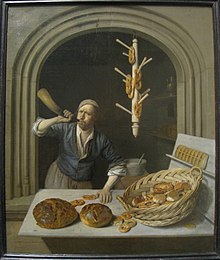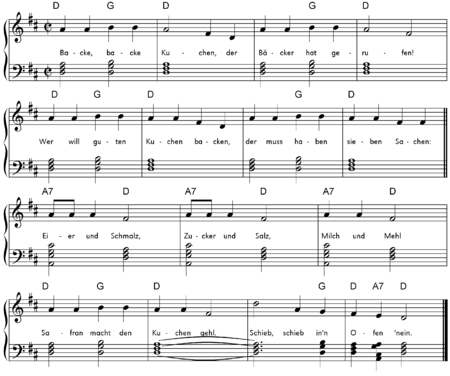Bake bake cake
Backe, backe Kuchen is a popular German language children's song . The origin isassumedin Saxony and Thuringia before the year 1840. There are different variants that differ in the text and the number of stanzas. The rhyming text is sung to a simple, folk, and essentially pentatonic melody.
Text and melody
Bake, bake cake,
the baker called.
If you want to bake good cake, you
have to have seven things,
eggs and lard,
sugar and salt,
milk and flour,
saffron makes the cake flour!
Push, push in an oven, no.
The melody structures the text musically in the sense of the reprise bar form . The framing lines (tunnels) are conventional four-bar periods in which only the melodic variation in the afterthought of the recapitulation (i.e. in the last two bars) enlivens the otherwise rather monotonous course. What is interesting, on the other hand, is the oddity of the bars of the swan song, which runs counter to this symmetry (ie the “middle section”). This irregularity can often be found in folk songs as soon as “ litany-like ” texts with primarily enumerative content are set to music. Well-known songs that use this effect even more than the relatively simple cheek, bake cake with its three-bar swan song , are, for example, The farmer sends the Jockel or the English Christmas carol The Twelve Days of Christmas .
Text and variants

The text probably goes back to a widespread custom according to which the bakers "shouted" with a horn after the bread was baked to signal to the women in the neighborhood that the residual heat from the oven could now be used to bake their cakes. Even where the bread was baked in the communal village oven on certain days , there was a signal when the bread could be removed and the residual heat from the oven could be used to bake cakes.
The original form of the text with the rhyming enumeration of the ingredients can already be found around 1450 in Maister Hannsen's von Wirtenberg Koch cookbook , where the preparation of a mousse is reported:
Who a guot muos wil have
the mach of sibennler sachen
du muost have milk, saltz and schmaltz,
zugker, ayer and mel
saffran dar to
so it is gell.
It is noticeable that the text refers to the yellowing effect of saffron . None of the other six ingredients mentioned offer an obvious rhyming word for the New High German "yellow". Therefore, the traditional lyric writing "gehl" (also called "gel"), which - as in the Upper Saxon Gehlchen , the chanterelle - as pale beside falb exists (Middle High German "gel" is found more frequently than in the late Middle Ages and thus around 1450 yellow and In early New High German, jaundice is also called gel addiction ) and an end rhyme for "flour" is guaranteed. There are Upper German dialects, e.g. B. the Northeast Bavarian, which soften the final “-b” to “-w” so that it was no longer heard or not spoken at all. In addition, "geel" is the Low German and Dutch word for "yellow".
The last line (push, push in the oven) is only added for some variants.
literature
- Franz Magnus Böhme : German children's song and children's game . Breitkopf and Härtel, Leipzig 1897, pp. 46–48 ( Textarchiv - Internet Archive ).
- Ludwig Erk , Franz Magnus Böhme : German song library . Volume 3. Breitkopf and Härtel, Leipzig 1894, p. 588 ( hathitrust.org ).
- Karl Simrock (Hrsg.): The German people books. Volume 9. Brönner, Frankfurt am Main 1856, p. 84 f. ( Digitized in the Google book search).
- Ingeborg Weber-Kellermann : The book of children's songs. 235 old and new songs: cultural history - sheet music - lyrics. Atlantis-Schott, Mainz 2002, ISBN 3-254-08370-9 , p. 189.
Web links
- Entry at volksliederarchiv.de with sources in song collections
- Xaver Frühbeis: Recipe from Maister Hannsen. "Bake bake cake". BR-Klassik, extra midday music, January 5, 2014
Individual evidence
- ↑ From oven, bakeries and bakeries , diebackstube.de, accessed on December 7, 2012
- ^ Culinary Art in the Late Middle Ages , accessed on October 5, 2013
- ^ Friedrich Kluge , Alfred Götze : Etymological dictionary of the German language . 20th ed., Ed. by Walther Mitzka , De Gruyter, Berlin / New York 1967; Reprint (“21st unchanged edition”) ibid 1975, ISBN 3-11-005709-3 , p. 244.
